Saturday, October 09, 2004
Billon antoninianus, Gallienus, Köln, Göbl 870d
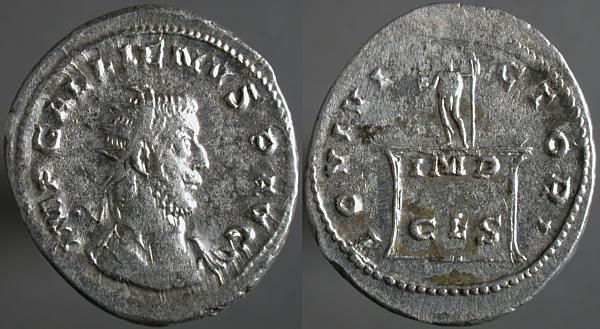
IMP GALLIENVS·P·AVG, Radiate cuirassed bust right | IOVI VICTORI, Statue of Jove standing facing, head left, holding scepter right and Victory right, all on large pedestal marked IMP / C E S.
The pedestal markings are interpreted as imperator cum exercitu suo, "the general with his armies," the authors of the victory over the Germanic tribes that the coin commemorates.
Friday, October 08, 2004
Æ30, Side in Pamphylia, Salonina, SNG von Aulock 4862
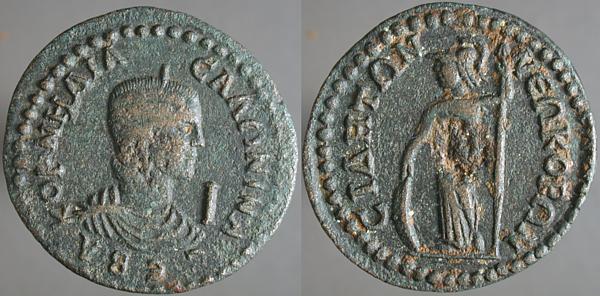
ΚΟΡΝΗΛΙΑ CΑΛΩΝΙΝΑ CΕΒΑ, Diademed draped bust, I before | CΙΔΗΤΩΝ ΝΕΩΚΟΡΩΝ, Athena standing facing, head left, holding spear right, and shield at her feet left.
A rather severe portrait of Salonina here, from a mint that's usually a bit more sympathetic.
Thursday, October 07, 2004
Billon antoninianus, Valerian, Viminacium, Göbl 111b
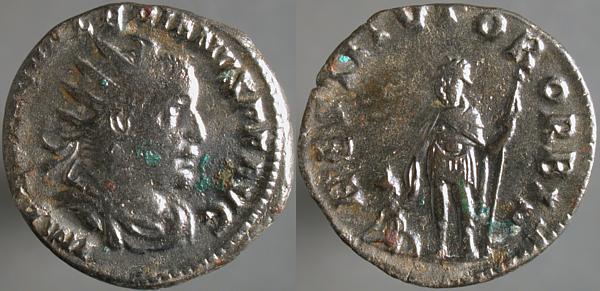
IMP C P LIC VALERIANVS P F AVG, Radiate draped cuirassed bust right | RESTITVTOR ORBIS, Emperor standing in military garb right, holding scepter right, raising kneeling figure left.
In June, I posted a sestertius of Gallienus featuring this reverse. Here's a rounder, perhaps clearer, example of it in the debased silver alloy called billon, which was as close as Roman coins came to silver during this era.
The antoninianus (which is the modern name, we don't really know what the Romans called them) was, like debasing the metal, a scam. Tariffed at two denarii, it originally contained as much silver as 1-1/2 and it declined in intrinsic value as the alloy contained less and less silver. During the reign of Gallienus the alloy became so debased that it no longer looked silver, and techniques had to be devised to continue the deceit by getting silver on the surfaces of the coin.
Wednesday, October 06, 2004
Happy, happy!
Go visit rogueclassicist for his birthday!
AV stater, Coson-Cotiso, Dacia, Sear GCV 1733
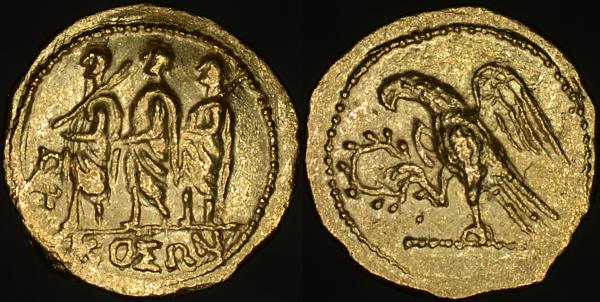
Roman consul walking left, accompanied by two lictors; ΒΑ monogram to left, ΚΟΣΩΝ in exergue. | Eagle standing left on sceptre, holding wreath.
There's much disagreement on the origin of this coin, one of the commonest and most affordable ancient gold coins.
To begin with what's certain: the obverse clearly echoes the reverse of this coin of M. Junius Brutus, famous assassin, minted in 54 BCE.
The reverse echoes the reverse of this coin of Q. Pomponius Rufus, a little-known moneyor of 73 BCE.
The apparent connection to the assassination of Julius Caesar, and to the extremely valuable "EID MAR" coinage of Brutus was so compelling that theories of the 19th century, still popular with some sellers, have these struck for Brutus by an otherwise unknown Thracian dynast. The monogram on the obverse, when present (a variety lacks this monogram) was generally read BR, for Brutus.
Ancient Thrace is today Bulgaria, but these coins are overwhelmingly found in Transylvania, in Romania, ancient Dacia.
A more current theory, seen here and here is that the coins were struck by a Geto-Dacian king frequently known as Cotiso, used simplified designs from their Roman neighbors, as they had earlier produced simplified copies of Macedonian coins. The monogram is read ΒΑ for Βαςιλευς; "King."
Some further discussion here, and I can't find a link to the speculation that these are not ancient at all, but are the work 16th century miners who didn't wish to be taxed for selling their gold or executed for counterfeiting contemporary issues.
There is silver or bronze coinage known for King Cotiso, but the use of Roman designs on the gold may indicate that they used whatever came to hand. Why the minted this gold, and where the gold came from, remain unclear.
Since the collapse of Soviet communism there have been a lot of these available, as coins long hidden from the government can now be sold, even if not quite openly. The market is a bit saturated, and while there's no danger that prices will ever reach melt value, they are still declining. Naturally, I hope I guessed the low point to purchase mine, and that they'll trend back up now.
It worked that way when I bought my house, chose just the right week to take a mortgage!
Tuesday, October 05, 2004
Æ23, Anazarbus in Cilicia, Valerian, SNG Copenhagen 60
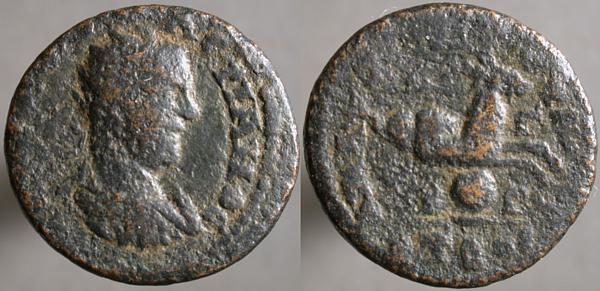
[ΑVΤ Κ Ο]VΑΛΕΡΙΑΝΟC CΕ, Radiate draped cuirassed bust right | ΑΝΑΖΑΡΒΟV ΜΗΤΡ, Capricorn right, above globe which has a Γ to either side. Α Μ Κ in left field, ΕΤ ΒΟC in exergue.
I've been looking for one of these for a while, with a small assortment of odd misadventures, twice buying coins that turned out to be of the emperor Volusian. Finally found one, though.
If I better understood Roman astrology, I might have a grasp on the significance of the capricorn here.
Monday, October 04, 2004
Billon antoninianus, Gallienus, Viminacium, Göbl 809o
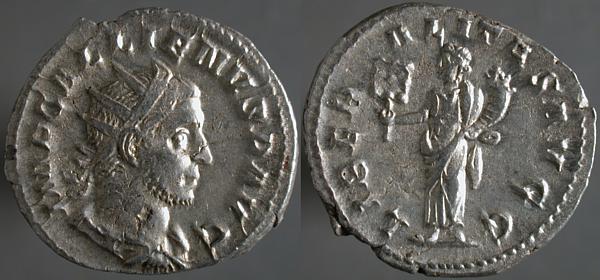
IMP GALLIENVS P AVG, Radiate draped cuirassed bust right | LIBERALITAS AVGG, Liberalitas standing facing, head left, holding cornucopia right and counting-board left.
I've previously posted a coin featuring Liberalitas, the personification of imperial generosity and the dole.
As much as they used force when they chose, the Romans clearly understood the overwhelming value of making people dependant on the government simply by relieving them of the need to shift for themselves. Consider this modern parable, variously titled "The Wild and Free Pigs of the Okefenokee Swamp" or "The Price of Free Corn."
In much the same way the proud citizens of the Roman republic were tamed to the rule of emperors.
Sunday, October 03, 2004
Æ30, Side in Pamphylia, Gallienus, Sear GIC 4540
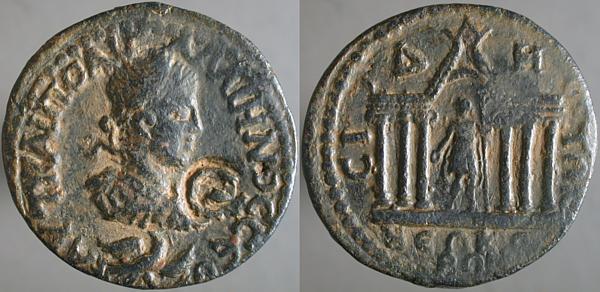
ΑVΤ ΚΑΙ ΠΟ ΛΙ ΓΑΛΛΙΗΝΟC CΕΒ, Laureate draped cuirassed bust right over eagle with wings spread. E countermark before | CΙ_Δ_Η_ΤΩΝ / ΝΕΩΚΟ / ΡΩΝ, Emperor standing facing, head left, holding scepter right and patera left, in hexastyle neokorate temple.
While the idea of the emperor as a living god was offensive to citizens of the city of Rome, it was well established in the provinces, where they were inured to it from the Hellenistic period or before. Being the site of one or more Neokorate temples, dedicated to the cult of the imperial family, was a point of pride for a city, particularly when the neighbors had fewer, or none.

